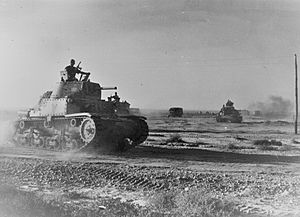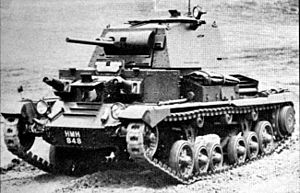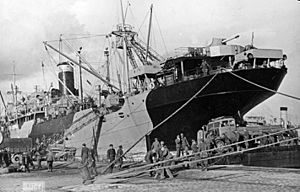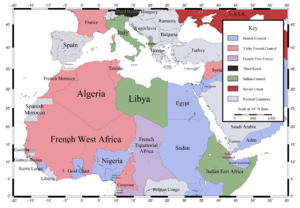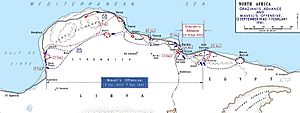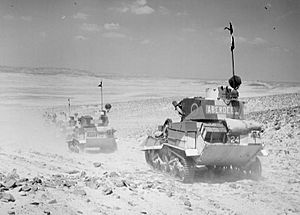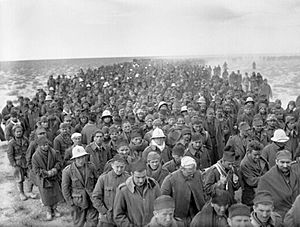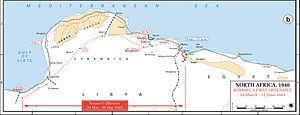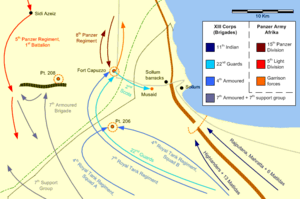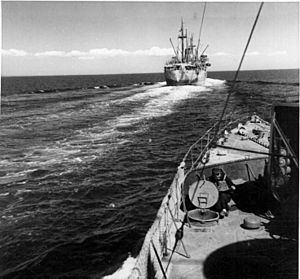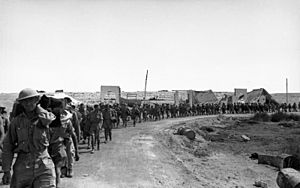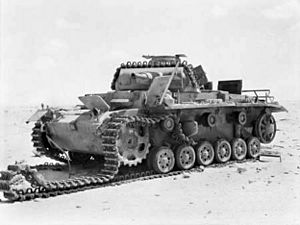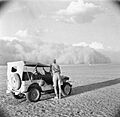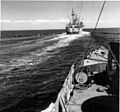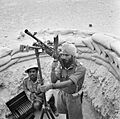Western Desert campaign facts for kids
The Western Desert campaign (also called the Desert War) was a major part of the North African campaign during World War II. It took place in the deserts of Egypt and Libya. The fighting started in June 1940 when Italy declared war. In September, Italian forces invaded Egypt from Libya.
Quick facts for kids Western Desert campaign |
|||||||
|---|---|---|---|---|---|---|---|
| Part of the North African campaign of the Second World War | |||||||
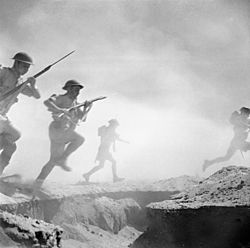 British infantry advance at El Alamein, 24 October 1942 |
|||||||
|
|||||||
| Belligerents | |||||||
|
|
|
||||||
| Commanders and leaders | |||||||
| Casualties and losses | |||||||
| North Africa 220,000 35,476 killed |
North Africa 620,000 32,342 killed |
||||||
In December 1940, the British launched Operation Compass. This surprise attack was so successful that it destroyed a large Italian army. Italy's leader, Benito Mussolini, asked Adolf Hitler for help. Hitler sent a German force, the Afrika Korps, led by General Erwin Rommel. This force was officially under Italian command.
In spring 1941, Rommel's forces pushed the Allies back into Egypt. They also started the siege of Tobruk, a port city. Later in 1941, the Allies defeated Axis forces in Operation Crusader, forcing them to retreat. In early 1942, Axis forces pushed the Allies back again. They captured Tobruk after the Battle of Gazala.
The Axis then invaded Egypt. The Allies retreated to El Alamein. Here, the British Eighth Army fought two important defensive battles. In October 1942, they finally defeated the Axis forces in the Second Battle of El Alamein. The Eighth Army then chased the Axis out of Libya and into Tunisia. Allied forces also invaded Tunisia from the west in Operation Torch. The remaining Axis forces in Tunisia surrendered in May 1943.
The British forces, later known as the Eighth Army, were sometimes weakened. This happened when units were sent to other battles, like in Greece. However, more troops and supplies, including American tanks, arrived for the Eighth Army over time. The Axis forces always struggled with getting enough supplies. The desert war became less important for Germany as their invasion of the Soviet Union (Operation Barbarossa) did not end quickly.
Why the War Started in the Desert
Libya: An Italian Colony
Cyrenaica, a region in Libya, had been an Italian colony since 1911–1912. Italy wanted to defend its borders with French Tunisia to the west and British-controlled Egypt to the east. Marshal of the Air Force, Italo Balbo, was in charge of Italy's forces in Libya.
Italy had two main armies in Libya: the 5th Army in the west and the 10th Army in the east. In mid-1940, these armies had many divisions. Each division had thousands of soldiers. Italian soldiers had good morale and recent battle experience. The Italian air force, however, was not as strong as it could have been.
When war was declared, the 10th Army moved its troops towards the Egyptian border. The 5th Army stayed in the west, facing Tunisia.
Egypt: A British Base
Britain had troops in Egypt since 1882. However, their numbers were reduced by a treaty in 1936. The small British and Commonwealth forces protected the Suez Canal. This canal was very important for Britain's communication with its territories in Asia and the Indian Ocean.
In 1939, Lieutenant-General Archibald Wavell became the commander of British forces in the Middle East. Before France surrendered in 1940, French troops in Tunisia faced the Italian 5th Army. In Libya, Italy had about 215,000 soldiers. In Egypt, Britain had about 36,000 troops. Another 27,500 were training in Palestine.
British forces included the 7th Armoured Division. This was one of only two British armoured training groups. In June 1940, Major-General Richard O'Connor took command of the Western Desert Force. His job was to push back the Italians from their border posts. The 7th Armoured Division moved towards the border to act as a covering force. The RAF also moved most of its bombers there.
The Western Desert Force was reinforced. Although Italian forces in Libya greatly outnumbered the British in Egypt, they had older equipment and lower morale. Italy declared war on June 11, 1940.
The Desert Environment and Supplies
The Desert Terrain
The war was mostly fought in the Western Desert. This area was about 240 miles (386 km) wide. It stretched from Mersa Matruh in Egypt to Gazala on the Libyan coast. The only paved road was the Via Balbia. Inland, the Sand Sea marked the southern edge of the desert.
The desert is a flat, stony plain. It rises about 500 feet (152 m) above sea level. It stretches south for 124–186 miles (200–300 km) from the coast. The region has scorpions, vipers, and flies. Only a few Bedouin nomads lived there.
Bedouin tracks connected water wells. Soldiers navigated using the sun, stars, and compass. They also used their "desert sense." This was a good understanding of the environment gained from experience. In spring and summer, days were very hot and nights were very cold. The Sirocco (or Ghibli) was a hot desert wind. It blew fine sand, reducing visibility and getting into everything. Vehicles and aircraft needed special oil filters. All supplies had to be brought in from outside. German tank engines often overheated. Their lifespan dropped significantly due to the harsh conditions.
Getting Supplies to the Front
Axis Supply Challenges
Italian supply ships to Libya had to travel a long way around Sicily. This was to avoid British aircraft and submarines based at Malta. Once in Africa, supplies had to be moved huge distances by road. The distance from Tripoli to Benghazi was about 650 miles (1,046 km). To El Alamein, it was 1,400 miles (2,253 km).
Many Italian merchant ships were stuck in British ports when the war started. By September 1942, half of the remaining ships had been sunk. From June 1940 to May 1943, 16 percent of all supply shipments were sunk.
Tobruk was used as a port in June 1942. However, Allied bombing and its long approach route made it difficult. The Germans estimated that an army could only operate about 200 miles (322 km) from its base. But about a third of Axis trucks were often broken. Also, 35–50 percent of the fuel was used just to transport the rest to the front. Italy also had fuel shortages. The small ports in Libya made it hard to unload many supplies. The German army command realized they couldn't supply their forces for a major attack unless Italian forces were sent back to Italy. This was not possible politically.
British Supply Challenges
Italy's location meant it could potentially block the Mediterranean Sea. This would force the British Mediterranean Fleet to rely on the Suez Canal. In 1939, Wavell planned to build a large base in the Middle East. This base would support about fifteen divisions (300,000 men). Many supplies were imported from British colonies. Others were found locally.
After Italy declared war in 1940, merchant ships had to travel around the Cape of Good Hope. This made Egypt as far away as Australia. The Middle East Supply Centre (MESC) worked to coordinate imports. It also helped create local substitutes for food and improve farming. By March 1943, the MESC had replaced many imports with local production.
In 1940, British forces had a base at Mersa Matruh, 200 miles (322 km) west of Alexandria. They started building a water pipeline. Wells were dug, but most filled with salt water. The main fresh water sources were old Roman aqueducts. Water-boats from Alexandria and a distillation plant helped. But strict water rationing was still needed. Not enough vehicles were available in 1939. Only desert-worthy vehicles could go off-road. This meant tanks couldn't move far from Matruh.
An invading force would have to cross a waterless desert to reach the main British force. In September 1940, work began on a coastal railway. It reached Sidi Barrani by October 1941 and Tobruk by December 1942. This railway carried 4,200 long tons (4,267 t) of water per day.
1940: Early Battles
Border Skirmishes
Hostilities began on June 11, 1940. British troops were ordered to control the border. They crossed into Libya that night. They exchanged fire with Italian troops at Sidi Omar. Some Italians didn't even know war had been declared. On June 14, the British captured Fort Capuzzo and Fort Maddalena. They took 220 prisoners. Two days later, the British attacked an Italian convoy. They killed 21 Italian soldiers and took 88 prisoners. This included a Brigadier General.
The British patrolled the border area. They went as far west as Tobruk. They showed their dominance over the Italian 10th Army. A period of quiet followed from August to early September. The British claimed to have caused 3,500 casualties. They only lost 150 men between June 11 and September 9. Both sides also set up scouting groups. These groups, like the Long Range Desert Group (LRDG), explored the desert. They raided and watched enemy movements.
Italian Invasion of Egypt
Benito Mussolini had not planned to invade Egypt. But after France fell in 1940, Italy could send more troops east. On August 7, Mussolini ordered an invasion. He wanted to occupy Egypt and connect with Italian East Africa.
On September 13–18, the Italian invasion of Egypt began. It was a limited attack towards Mersa Matruh. This was due to a lack of transport, fuel, and radios. The Italians occupied Musiad and Sollum. They pushed past British harassing parties. The British withdrew, but kept bothering the Italian advance. They fell back to Sidi Barrani. The Italians occupied Sidi Barrani and then stopped.
Despite Mussolini's urging, the Italians dug in around Sidi Barrani. They repaired roads and cleaned wells. They also started building a water pipeline from the border. They gathered supplies for a new advance in mid-December. Egypt broke off relations with the Axis powers. Italian aircraft bombed Cairo on October 19.
British naval and air attacks continued to bother the Italian army. These attacks lowered Italian morale. British armoured car patrols controlled the area between the armies. The British prepared for a raid on the Italian camps. They had been reinforced with new Matilda II tanks.
Operation Compass: A British Surprise Attack
Operation Compass began on December 9, 1940. The British attacked the Italian camps near Sidi Barrani. The 4th Indian Division and the 7th Royal Tank Regiment attacked Nibeiwa at dawn. They quickly took the camp. Then they moved on to Tummar West, which also fell.
Battle of Sidi Barrani
On December 10, the British cut the coast road. The 7th Armoured Division cleared the area around Buq Buq, taking many prisoners. On December 11, the Italians were defeated at Sidi Barrani. Rabia and Sofafi were abandoned. The 7th Armoured Division chased them along the coast. By December 16, the British had taken Sidi Omar. They forced the Italians to retreat to Bardia. From December 9 to 11, the British took 38,300 prisoners. They also captured 237 guns and 73 tanks. They only suffered 624 casualties.
Battle of Bardia
Bardia fell between December 14 and January 5, 1941. The British suffered 456 Australian casualties. They lost 17 of 23 tanks. But they took 40,000 Italian prisoners. They also captured over 400 guns and 130 tanks. On January 21, Australian infantry broke into Tobruk. They made a path for 18 British tanks. The Australians took 25,000 prisoners, 208 guns, and 87 tanks. They lost 355 Australians and 45 British troops.
The 7th Armoured Division drove 100 miles (161 km) towards Derna. An Italian tank group, the Babini Group, was at Mechili. This group escaped. From January 26 to 28, British tanks got stuck in heavy rain. Derna was abandoned the next day. The 7th Armoured Division sent a fast-moving group called Combeforce to Beda Fomm. Their goal was to cut off the Italian 10th Army.
Battle of Beda Fomm
| Place | PoW | Tanks | Guns |
|---|---|---|---|
| Sidi Barrani | 38,289 | 73 | 297 |
| Sidi Omar | 900 | 0 | 8 |
| Bardia | 42,000 | 130 | 275 |
| Tobruk | 25,000 | 87 | 208 |
| Mechili | 100 | 13 | 0 |
| Derna Benghazi |
2,000 | 10 | 24 |
| Benghazi Agedabia |
25,000 | 107 | 93 |
| Total | 133,298 | 420 | 845 |
In late January, the British learned that the Italians were leaving Cyrenaica. They were using the Via Balbia road from Benghazi. The 7th Armoured Division was sent to cut off the Italian 10th Army. They went through the desert south of the Jebel Akhdar mountains. The 6th Australian Division chased the Italians along the coast road.
The desert was tough for British tanks. Combeforce, a group of wheeled vehicles, was sent ahead. On February 5, Combeforce reached the Via Balbia south of Benghazi. They set up roadblocks. The leading parts of the 10th Army arrived 30 minutes later. They found the road blocked. The next day, the Italians attacked to break through. They kept attacking into February 7. With British reinforcements arriving, the 10th Army surrendered. From Benghazi to Agedabia, the British took 25,000 prisoners. They captured 107 tanks and 93 guns. In total for Operation Compass, the British captured 133,298 men, 420 tanks, and 845 guns.
On February 9, British Prime Minister Winston Churchill ordered the advance to stop. Troops were sent to Greece to help in the Battle of Greece. The British couldn't go beyond El Agheila anyway. Their vehicles were breaking down. The supply line from Egypt was too long. A few thousand Italian soldiers escaped. German reinforcements, the first units of the Afrika Korps, were sent to Libya.
1941: German Forces Arrive
Tobruk and the Greek Campaign
A week after the Italian surrender, London ordered Cyrenaica to be held with minimal forces. All extra troops were to be sent to Greece. The 6th Australian Division was sent to Greece in March. The 7th Armoured Division was worn out and needed repairs. The 2nd Armoured Division was also in bad shape. The new 9th Australian Division took over in Cyrenaica. They thought the Italians couldn't counter-attack until May, even with German help.
Operation Sunflower: Rommel's First Attack
In early 1941, the situation quickly changed. The best British units went to Greece. Adolf Hitler sent the new Afrika Korps (DAK) to Libya. This force had fresh troops, better tanks, and air support. It was led by General Erwin Rommel. Rommel had been very successful in the Battle of France.
The Axis force attacked and quickly defeated the British at El Agheila on March 24. They pushed the British back to the border by April 15. They also started the siege of Tobruk. The British commanders, Lieutenant-General Philip Neame and Major-General Michael Gambier-Parry, were captured. The rest of the 2nd Armoured Division was destroyed. Several Axis attempts to take Tobruk failed. The front line then settled on the Egyptian border.
The Siege of Tobruk
Tobruk was defended by about 25,000 Eighth Army troops. They had plenty of supplies. The Royal Navy kept them connected to Egypt. The garrison had armoured cars and captured Italian tanks. They could attack Axis supply convoys passing by Tobruk. This stopped the Axis from invading Egypt. Rommel tried to take the port, but the 9th Australian Division defended it strongly. Several attacks were pushed back. After three weeks, Rommel stopped the attacks and continued the siege. Italian infantry divisions surrounded the fortress. Most of the Afrika Korps stayed mobile south and east of the port.
Operation Brevity
Operation Brevity (May 15–16) was a small British attack. It aimed to weaken Axis forces and secure positions for a larger attack on Tobruk. The British attacked with tanks and infantry in three groups. They captured Sollum, Halfaya Pass, and Fort Capuzzo. But the fort was lost to a counter-attack. A German counter-attack on May 16 forced a British retreat. The British lost 206 casualties. Five tanks were destroyed and 13 damaged. German casualties were 258 men. Italian casualties were 395, with 347 captured. On May 12, a convoy brought 238 tanks and 43 aircraft to Alexandria. This helped re-equip the 7th Armoured Division.
Operation Scorpion
On May 26, a German battle group attacked Halfaya Pass. They tried to bluff the British into retreating. But it became a real attack. The Germans secured a strong position. Brigadier William Gott ordered a withdrawal. The British had no nearby reinforcements. Gott ordered a full retreat from the pass. Axis forces re-occupied it. The Italo-German positions were fortified with barbed wire and minefields. They were covered by 50 mm and 88 mm anti-tank guns. The Axis began to gather supplies. The 15th Panzer Division started arriving on May 20.
Operation Battleaxe
Operation Battleaxe (June 15–17, 1941) aimed to lift the siege of Tobruk. It also aimed to recapture eastern Cyrenaica. The 7th Armoured Division and an infantry force attacked. The infantry attacked near Bardia, Sollum, Halfaya, and Capuzzo. Tanks protected the southern flank. For the first time, a large German force fought defensively.
The attack on Halfaya Pass failed. Only one of three attacks on Hafid Ridge had any success. By the end of June 15, only 48 British tanks were working. On June 16, a German counter-attack pushed back the British. But the British were down to only 21 working cruiser tanks and 17 infantry tanks.
On June 17, the British barely escaped being surrounded. They ended the operation. The British had 969 casualties. They lost 27 cruiser tanks and 64 infantry tanks. The RAF lost 36 aircraft. German losses were 678 men. Italian losses are unknown. They also lost 12 tanks and 10 aircraft. This British failure led to the replacement of several commanders, including Wavell. General Claude Auchinleck took over as Commander-in-Chief of the Middle East Command. In September, the Western Desert Force was renamed the Eighth Army.
Operation Crusader
The Eighth Army, led by Lieutenant-General Alan Gordon Cunningham, launched Operation Crusader from November 18 to December 30. Their goals were to relieve Tobruk and capture eastern Cyrenaica. The Eighth Army planned to destroy Axis tanks first. But they were pushed back several times. The 7th Armoured Division was defeated by the Afrika Korps at Sidi Rezegh.
Rommel ordered his tank divisions to relieve Axis positions on the Egyptian border. But he couldn't find the main Allied infantry force. They had bypassed the fortresses and headed for Tobruk. Rommel pulled his tanks back towards Tobruk. He had some tactical successes. This led Auchinleck to replace Cunningham with Major-General Neil Ritchie. The Axis forces then retreated west of Tobruk to the Gazala Line. Then they went back to El Agheila. This left the Axis garrisons at Bardia and Sollum isolated. These garrisons surrendered later.
The British suffered 17,700 casualties. The Axis had 37,400 casualties. Many were taken prisoner when the garrisons surrendered. Tobruk had been relieved. Cyrenaica was recaptured. Airfields were reoccupied to help supply convoys to Malta.
Axis Supply: 1940–1941
After Operation Compass, only Tripoli remained as a major port for Axis supplies. It could handle about 45,000 long tons (45,722 t) per month. Tripoli was 600 miles (966 km) from Benghazi along the Via Balbia. The road could flood and was vulnerable to the Desert Air Force (DAF). Using desert tracks wore out vehicles faster. The Axis advance of 300 miles (483 km) in early 1941 increased the road transport distance to 1,100 miles (1,770 km).
Benghazi was captured in April. Its coastal shipping capacity was only 15,000 long tons (15,241 t). It was also within DAF range. A German motorized division needed 350 long tons (356 t) of supplies a day. Moving these supplies 300 miles (483 km) needed 1,170 two-ton truck loads. With seven Axis divisions, plus air force and naval units, 70,000 long tons (71,123 t) of supplies were needed per month.
From February to May 1941, more than enough supplies arrived. Attacks from Malta had some effect. But in May, 91 percent of supplies still arrived. However, a lack of transport in Libya meant German supplies piled up in Tripoli. The Italians only had 7,000 trucks for their 225,000 men.
Fewer Axis attacks on Malta from June led to more ship losses. Losses increased to 25 percent in September. Deliveries averaged 72,000 long tons (73,150 t) a month from July to October. But 30 to 50 percent of fuel was used by road transport. Also, 35 percent of trucks were out of service. This reduced deliveries to the front. In November, a five-ship convoy was sunk during Operation Crusader. Ground attacks on road convoys stopped daylight journeys. Lack of deliveries and the Eighth Army offensive forced a retreat to El Agheila from December 4. This crowded the Via Balbia. British ambushes destroyed about half of the remaining Axis transport.
Convoys to Tripoli restarted. Losses increased. But by December 16, the supply situation had improved, except for fuel. In December, the Luftwaffe was limited to one flight per day. The Italian navy used warships to carry fuel to Derna and Benghazi. They made a huge effort from December 16 to 17. Four battleships, three light cruisers, and 20 destroyers escorted four ships to Libya. Using such a large fleet for 20,000 long tons (20,321 t) of cargo used up the navy's fuel reserves. Only one more battleship convoy was possible.
1942: Turning Point Battles
Operation Theseus
The Eighth Army's advance to El Agheila stretched their supply lines. In January 1942, the British pulled back to reduce supply problems. They also prepared for Operation Acrobat, a plan to advance west into Tripolitania. The British overestimated Axis losses during Operation Crusader. They thought they faced 35,000 troops, not the actual 80,000. They also misjudged how fast Axis reinforcements would arrive. The Eighth Army expected to be ready by February, well before an Axis attack.
Panzerarmee Afrika began Operation Theseus on January 21. They defeated the 2nd Armoured Brigade. By January 23, the brigade was down to 75 tanks from 150. The Germans lost 29 tanks out of 100. Benghazi fell on January 28. By February 6, the British were back at the Gazala line. This was a few miles west of Tobruk. The British had 1,309 casualties from January 21. They lost 42 tanks and 40 field guns. The commander of XIII Corps resigned.
Battle of Gazala
By February, the front was at the Gazala Line, west of Tobruk. In the spring, both sides prepared for another battle. The British planned Operation Buckshot for June. It aimed to destroy the Panzerarmee and recapture Cyrenaica. But in early May, defensive measures on the Egyptian border became more important. An Axis attack was coming.
Operation Venezia (the Battle of Gazala) began on May 26, 1942. The Afrika Korps and Italian tanks drove south. They went around the side of the Gazala line. But they were cut off by Free French and other Allied troops at Bir Hakeim. These troops stopped Axis supply convoys.
Rommel retreated to a position next to the British minefields. Ritchie ordered Operation Aberdeen, a counter-attack, for June 5. To the north, the 32nd Army Tank Brigade lost 50 of 70 tanks. The 7th Armoured Division and the 5th Indian Infantry Division attacked. But the British artillery fire fell short of the German anti-tank guns. The 22nd Armoured Brigade lost 60 of 156 tanks and turned away. This left the 9th Indian Brigade stranded. An afternoon counter-attack by Italian and German divisions overran British headquarters. The British fled from the Gazala Line on June 13. They had only 70 working tanks left.
Fall of Tobruk
Lieutenant-General Gott appointed Major-General Hendrik Klopper to defend Tobruk. The garrison included two South African brigades, a Guards brigade, an Indian brigade, a tank brigade, and an anti-aircraft brigade. Tobruk had been under siege for nine months in 1941. But this time, the Royal Navy couldn't guarantee supplies. Auchinleck thought Tobruk could be sacrificed. But he expected it to hold out for two months. On June 21, 35,000 Eighth Army troops surrendered to the Italians. Auchinleck replaced Ritchie. He took over the Eighth Army. He stopped the Axis advance at El Alamein, 70 miles (113 km) from Alexandria. After the First Battle of El Alamein, Auchinleck was also replaced.
Operation Hercules: The Canceled Malta Invasion
Italian plans to invade Malta by sea began in the 1930s. An opportunity to capture Malta came in April 1941. But the invasion of Crete was done first. It caused so many losses that a second operation in 1941 was impossible. German air units then went east for the invasion of the Soviet Union. By June 1941, Malta's air defenses had recovered.
German air units returned to the Mediterranean in spring 1942. They managed to weaken Malta's ability to attack. In April, Hitler and Mussolini agreed to launch Operation Hercules. This was an Italian-German air and sea invasion. Many transport aircraft, gliders, and Italian transport aircraft were gathered. The Italian navy gathered a large fleet of ships. The German navy also contributed landing craft.
Rommel wanted to attack in Libya. He wanted to get ahead of an Eighth Army offensive. Hitler and Mussolini agreed. But the advance was supposed to stop at Tobruk. This was to prepare for the Malta invasion in August. After the success at Gazala and the capture of Tobruk in June, the Panzerarmee kept advancing. Chasing a defeated enemy seemed more appealing than the risks of the Malta operation. Hercules was canceled. Instead, they planned Operation Aïda, an invasion of Egypt to capture the Suez Canal.
Operation Aïda: The Push into Egypt
Panzerarmee Afrika advanced into Egypt after the victory at Gazala. They chased the Eighth Army. The Eighth Army made a defensive stand at Mersa Matruh. The Panzerarmee's speed allowed it to get behind British corps. But the Axis forces were too weak to stop the British from escaping. XIII Corps withdrew on the evening of June 27. But poor communication left X Corps alone in Mersa Matruh. X Corps broke out the next night. But they left 6,000 men and much equipment behind.
The Eighth Army continued to retreat east. They clashed with Axis forces several times. An attempt to regroup at Fuka was canceled. Auchinleck ordered a 100-mile (161 km) retreat all the way to El Alamein. This was 62 miles (100 km) west of Alexandria. The retreat brought the Eighth Army close to its base. This made supplies much easier. The Qattara Depression to the south made it hard for the Axis to go around their flank. By June 25, the Afrika Korps had only 60 tanks. The Italian XX Corps had only 14 working tanks. Using captured supplies, the Panzerarmee reached El Alamein on June 30. Supplying Axis forces so far east of Gazala became much harder. Most of their supplies still came from Tripoli, 1,400 miles (2,253 km) away.
First Battle of El Alamein
The First Battle of El Alamein (July 1–27, 1942) was an attempt to push the Eighth Army out of the Alamein position. After four days, Rommel called off the attack. This was because of the strong Eighth Army defense. Axis supplies were low. Their forces were shrinking. German divisions were down to 1,200–1,500 men each. By July 5, only about 30 German tanks were working.
After a quiet period, the Panzerarmee planned to attack again. But the Eighth Army attacked first. They attacked at Tel el Eisa from July 10 to 14. This exhausted both sides. The Eighth Army then attacked Italian units at Ruweisat Ridge (July 14–17). They attacked again at Tel El Eisa on July 22 and Miteirya Ridge (July 22 and 26). After this, another quiet period began. The Germans suffered about 10,000 casualties. Italian casualties are unknown. But 7,000 Axis prisoners were taken. The Eighth Army had 13,250 casualties.
Battle of Alam el Halfa
Lieutenant-General Bernard Montgomery took command of the Eighth Army in mid-August. Rommel tried to destroy the British. He wanted to reach Cairo before Allied reinforcements arrived in September. The Panzerarmee Afrika was in poor condition. Many German soldiers were tired from the climate and fighting. 19,000 German troops had been in Africa since March 1941. Reinforcements brought the four German divisions to 90,000 men. But only 34,000 of these were fighting troops. The Panzerarmee had about 200 German and 243 Italian tanks. The British had 700 tanks.
In the Battle of Alam el Halfa (August 30 – September 5), Axis units tried to surround the Eighth Army. They advanced around its southern flank. But the British had been warned by Ultra (decoded German radio messages). They left only patrols in the south. Most of the British tanks and guns were at the Alam el Halfa Ridge. This blocked the Axis advance 20 miles (32 km) behind the front. The tanks stayed on the ridge. They fought a defensive battle, not a moving one. Allied aircraft bombed Axis troops continuously. This destroyed few tanks. But it pinned them down. It also stopped the Panzerarmee from moving quickly.
Axis attacks on the ridge failed. Supplies ran short. Rommel ordered a withdrawal on September 2. Late on September 3, a New Zealand brigade and a British brigade counter-attacked. They tried to cut off the Axis retreat. But this attack was a costly failure. By September 5, the Axis retreat was complete. The Eighth Army lost 1,750 men and 68 tanks. The Axis lost 2,900 men, 49 tanks, 36 aircraft, 60 guns, and 400 trucks.
Second Battle of El Alamein
When the Eighth Army offensive began on October 23, the Panzerarmee had 104,000 men. This included 50,000 Germans. Only 24,173 were front-line troops. There were 496 Axis tanks, 290 of which were Italian. They also had 500 guns and 850 anti-tank guns. The Eighth Army had 195,000 men. They had 1,029 tanks, with another 1,000 under repair. They also had 908 guns and 1,451 anti-tank guns. The Allied troops were well-fed and healthy. Axis troops were undernourished and often sick. The Panzerarmee had only enough fuel for 180 miles (290 km) per vehicle.
By October 27, the Panzerarmee was down to 114 German tanks. By November 2, they had used most of their ammunition. They had only 32 German and 120 Italian tanks left. Rommel decided to retreat. But Hitler ordered the Panzerarmee to hold their ground. On November 4, the Eighth Army broke through Axis defenses. Rommel ordered the retreat to begin. He abandoned the non-motorized units, especially Italian ones, in the center and south.
Panzerarmee Afrika suffered 37,000 casualties. This was 30 percent of their force. They lost 450 tanks and 1,000 guns. The Eighth Army suffered 13,500 casualties. This was a much smaller part of their force. They lost 500 tanks (only 150 destroyed) and about 110 guns. The Panzerarmee was reduced to about 5,000 men, 20 tanks, 20 anti-tank guns, and 50 field guns. Attempts to surround the Axis forces at Mersa Matruh failed. Most of the Afrika Korps escaped by November 7. The Axis forces retreated along the coast road. But they lacked tanks and fuel for a mobile defense. Tobruk was retaken by the Eighth Army on November 13. The Axis retreat continued. Benghazi fell on November 20. The captured ports were quickly repaired to supply the British advance.
Battle of El Agheila
Panzerarmee Afrika retreated to the El Agheila defenses. But Axis supply and reinforcement priority went to forces fighting the British First Army in Tunisia. This left the Italo-Germans with no ability to counter-attack. Hitler ordered the Mersa Brega line to be held at all costs. But Rommel preferred a fighting retreat to the Gabès Gap in Tunisia. This would increase the supply distance for the Eighth Army to 1,500 miles (2,414 km).
On November 24, Ugo Cavallero agreed to withdraw 200 miles (322 km) west to Buerat. This was 50 miles (80 km) beyond Sirte. This would happen if the Panzerarmee was attacked by a stronger force. The Eighth Army reached El Agheila on December 15. The New Zealand Division was sent to go around the Mersa Brega line from December 14 to 16. The 51st (Highland) Division attacked from the front. The 7th Armoured Division attacked inland. The outflanking move failed. The Panzerarmee retreated behind minefields and booby-traps. This slowed the pursuit.
Axis Supply: 1942
El Agheila was 460 miles (740 km) closer to Tripoli than the Egyptian border. The arrival of the second Italian battleship convoy on January 6, 1942, helped. The discovery of 13,000 long tons (13,209 t) of fuel at Tripoli also eased the supply crisis. The Panzerarmee had room to move. They also had a much shorter supply line. The British now had the burden of a very long supply line. The arrival of the Luftflotte II in Sicily also restored Axis air superiority. Rommel asked for 8,000 more trucks. But this was rejected. Rommel was warned that an advance would cause another supply crisis. On January 29, the Panzerarmee recaptured Benghazi. The next day, ammunition supply to the front broke down. By February 13, Rommel agreed to stop at Gazala, 900 miles (1,448 km) from Tripoli.
Until May, monthly deliveries averaged 60,000 long tons (60,963 t). This was less than the smaller Axis force received in 1941. But it was enough for an offensive. The 900-mile (1,448 km) advance to Gazala succeeded because Benghazi was open. This reduced the transport distance for about 33 percent of the Panzerarmee's supplies to 280 miles (451 km). The Italians tried to stop Rommel. They suggested capturing Malta first. This would delay another offensive in Africa until autumn. But they agreed to an attack on Tobruk for late May. The advance would stop at the Egyptian border. The Luftwaffe would then move to prepare for Operation Hercules.
The capture of Alexandria would have made Malta unimportant. But a defensive strategy would be needed. Benghazi would need to be expanded. Supplies would need to be gathered. Many reinforcements would need to be brought to Libya. More troops would increase the demand for supplies. This would go beyond the capacity of Tripoli and Benghazi. On May 26, Operation Venezia, the Battle of Gazala, began. Tobruk was captured intact on June 22. Shipping losses barely increased. Deliveries to Libya fell from 150,000 to 32,000 long tons (152,407 to 32,514 t). This was due to a fuel shortage in Italy. Supplies were unloaded at Tripoli. This made the Panzerarmee's position impossible to hold. Operation Hercules was postponed. The capture of 2,000 vehicles, 5,000 long tons (5,080 t) of supplies, and 1,400 long tons (1,422 t) of fuel at Tobruk allowed the Panzerarmee to advance another 400 miles (644 km) by July 4. Then, lack of supplies, exhaustion, and the Eighth Army's rally ended the advance.
Tobruk could only take 20,000 long tons (20,321 t) of supplies a month. It was also within DAF bomber range. The railway could carry only 300 long tons (305 t) per day. Small deliveries could be made to Tobruk, Bardia, and Mersa Matruh. Or they could be landed at Tripoli and Benghazi, 1,300 and 800 miles (2,092 and 1,287 km) away. Ship losses in August rose by 400 percent. Deliveries fell by half, to 51,000 long tons (51,818 t). Supplies were sent back to Tripoli. The Battle of Alam Halfa used 10,000 long tons (10,160 t) of fuel. Hitler forbade a retreat from El Alamein. Deliveries fell as fewer ships were sent from Italy. On the eve of the Second Battle of El Alamein, the railway from Tobruk flooded. 10,000 long tons (10,160 t) of supplies were stranded. This left the Panzerarmee with only ten percent of the fuel it needed.
1943: The End of the Campaign
Buerat and Tripoli
Rommel planned to defend the Gabes Gap in Tunisia. This was east of the French pre-war Mareth line. He wanted to hold the port of Buerat. Meanwhile, Army Group Africa, already in Tunisia, would face the British First Army. This army included US and French troops. The front was 400 miles (644 km) from Tobruk. With such supply difficulties, the Eighth Army couldn't use all its strength.
Buerat was not strongly defended. Despite knowing the state of Axis forces, Montgomery waited until January 16, 1943. By then, the Eighth Army had a 4:1 advantage in infantry. They had a 7.5:1 advantage in tanks. Bombing began on January 12. XXX Corps attacked on January 15. They moved along the coast road through minefields and traps. The 2nd New Zealand Division and the 7th Armoured Division swung inland. They were supplied by the Royal Army Service Corps. The Eighth Army needed to capture the port quickly to avoid a supply shortage.
Rommel withdrew from Buerat on January 15. He retreated from Tripoli on the night of January 22/23. He destroyed the port. Then he fought a delaying action into Tunisia. The 7th Armoured Division entered Tripoli on January 23. The last parts of Panzerarmee reached the Mareth line, another 200 miles (322 km) west, on February 15.
The main British attack was along the coast road. The 51st (Highland) Division and an armoured brigade led it. The 7th Armoured Division advanced through Tarhuna and Castel Benito. The 90th Light Division fought delaying actions along the road. This made Allied transport problems worse. From January 20 to 21, the 90th Light Division made a stand at Corradini. They had made 109 craters in the road. The leading part of the 7th Armoured Division reached Aziza on January 21. The next day, the 51st (Highland) Division reached Castel Verde.
A race developed. The Germans left Tripoli during the night. The 11th Hussars were the first into Tripoli on the morning of January 23. This was 675 miles (1,086 km) west of Benghazi. Five hours later, a Naval Base Party arrived. They looked at the destroyed port. On January 26, five ships anchored outside the port. They began to unload supplies. On January 30, 3,000 long tons (3,048 t) of stores were landed. In March, the Eighth Army entered Tunisia. On March 9, Rommel returned to Germany. He wanted to tell Hitler about the real conditions in North Africa. Rommel failed to convince Hitler to let the Axis forces withdraw. He was not allowed to return to Africa, supposedly for health reasons.
Images for kids
See also
- Egypt–Libya Campaign
- List of World War II battles
- Military history of Egypt during World War II
- Military history of Italy during World War II
- List of Italian military equipment in World War II
- Military history of the United Kingdom during World War II
- List of British military equipment of World War II
- Military history of Germany during World War II
- List of German military equipment of World War II
- North African campaign timeline


